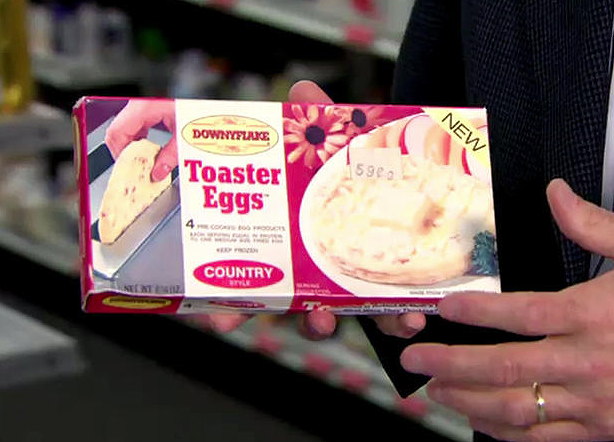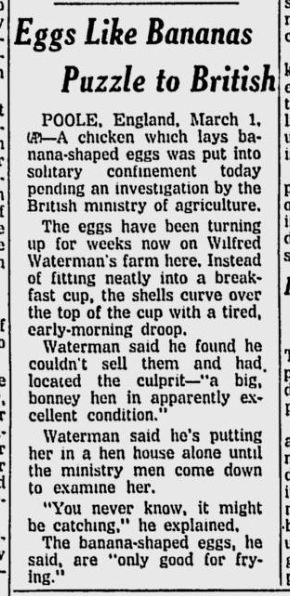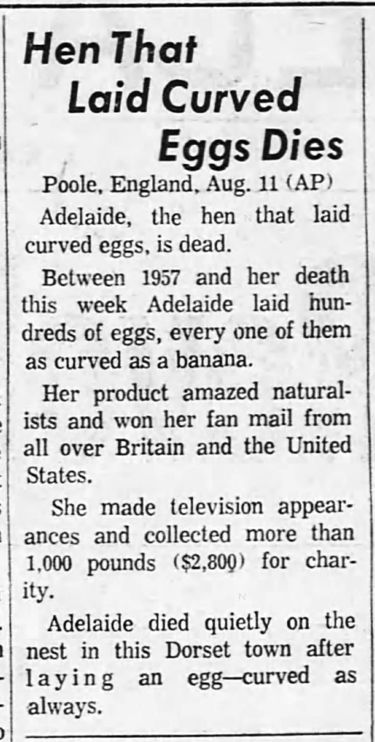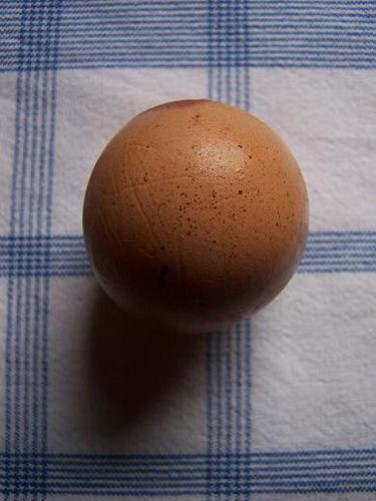Eggs
Toaster Eggs
A product of the 1970's toaster-cooking craze. Inspired by the popularity of Pop Tarts.They were introduced in 1972, and by 1975 were off the market.

Pittsburgh Press - Oct 1, 1972

Posted By: Alex - Sat Mar 03, 2018 -
Comments (3)
Category: Food, Eggs, 1970s
The Egg Wine Diet
It describes itself as the diet for "wine lovers that refuse to give up wine while losing weight." It consists of about 10 eggs a day, and wine.As the site notes, "Wine only have 600 calories per bottle. So compare that to a normal blt sandwich that has about the same. What would you rather have. The sandwich or a whole bottle of wine ?"
eggwinediet.com

Posted By: Alex - Fri Jan 26, 2018 -
Comments (2)
Category: Eggs, Dieting and Weight Loss
Egg Massage
Posted By: Paul - Sat Jul 29, 2017 -
Comments (0)
Category: Beauty, Ugliness and Other Aesthetic Issues, Eggs, 1960s, Europe
Artist Lays Egg

Poincheval hatching eggs
Chuck mentioned a few weeks ago that French performance artist Abraham Poincheval would soon be sitting on a dozen eggs until they hatch. He's now well into the process of doing that and has hatched nine eggs already.
More in extended >>
Posted By: Alex - Sat Apr 22, 2017 -
Comments (0)
Category: Publicity Stunts, Performance Art, Farming, Eggs
The Egg
Posted By: Paul - Fri Dec 30, 2016 -
Comments (4)
Category: Fantasy, Eggs, Stop-motion Animation, 1970s, North America
The Palatability of Eggs

Dr. Hugh Cott
He assembled a panel of three egg tasters, who were served the eggs scrambled. They then rated them on a 10-point scale. Over a six-year period (1946-1951) they tasted eggs from 212 bird species.
Some of their results: The domestic hen was rated tastiest (8.8 out of 10). The coot, moorhen, and lesser black-backed gull came in second place (8.3 out of 10).
Penguin eggs were "particularly fine and delicate in flavor." Domestic duck eggs were of only "intermediate palatability."
Coming in at the bottom were the eggs of the great tit ("salty, fishy, and bitter"), wren ("sour, oily"), and the oyster-catcher ("strong onion-like flavor"). The eggs of the bar-headed goose made the tasters gag. However, "The freshness of the material available may have been in question."
Cott concluded that brightly colored eggs were, overall, less palatable than camouflaged eggs, but this result has subsequently been challenged. Zoologist Tim Birkhead has also suggested that Cott's experiment would have been more scientifically valuable if the tasters had eaten the eggs raw, because "What predators ever experienced cooked eggs?"
Cott published the full results of his experiment in 1954, in the Journal of Zoology.

The Bend Bulletin - Feb 2, 1948
Posted By: Alex - Wed Nov 02, 2016 -
Comments (2)
Category: Food, Eggs, Experiments, 1940s
Inedible Egg Products

Original article here.
Even after reading this article about the big change in export rules for inedible egg products that occured in 1983, I still have no idea what these products are, or what they are used for.
Apparently, the baffling subject is still being thrashed out by the USDA thirty years later.
Posted By: Paul - Sat Sep 17, 2016 -
Comments (10)
Category: Food, Eggs, 1980s, Twenty-first Century
Adelaide, the hen who laid banana-shaped eggs
Adelaide the Hen (aka Adelaide Benteggs) lived on the farm of Wilfred Waterman in Poole, England. She first came to the attention of the press in 1957, when she began laying banana-shaped eggs. Farmer Waterman put her in solitary confinement, worried that whatever was causing her to lay such eggs "might be catching."Experts from the British Ministry of Agriculture subsequently x-rayed and otherwise examined Adelaide, but couldn't find anything obviously wrong with her that was causing her to lay the banana-shaped eggs.
Adelaide, however, kept laying the odd eggs — hundreds of them — and as a result became a celebrity hen. She appeared on TV and helped raise over £1000 for charity.
When she died, on August 11, 1961, it made international news. It was reported that she died quietly, sitting on her nest, after laying another curved egg. Officials from the British Museum expressed an interest in performing an autopsy on her, but before they could do so Farmer Waterman had her cremated. He kept the ashes in an urn on his sideboard.
Despite her fame, I've been unable to find a single picture anywhere of either Adelaide or one of her curved eggs, which I find puzzling. I would have thought that press photographers would have loved to document such an oddity.

Spokane Daily Chronicle - Mar 1, 1957

The Decatur Herald - Aug 12, 1961
Posted By: Alex - Sun Jul 17, 2016 -
Comments (0)
Category: Animals, Eggs, 1950s, Bananas
“Life-sized” Alien Facehugger & Egg

Too bad this won't be available until April 2016. Imagine the screams of terror, as depicted, when your lucky first-grader opens this under the Xmas tree.
Posted By: Paul - Fri Nov 20, 2015 -
Comments (5)
Category: Aliens, Death, Toys, Children, Eggs

| Who We Are |
|---|
| Alex Boese Alex is the creator and curator of the Museum of Hoaxes. He's also the author of various weird, non-fiction, science-themed books such as Elephants on Acid and Psychedelic Apes. Paul Di Filippo Paul has been paid to put weird ideas into fictional form for over thirty years, in his career as a noted science fiction writer. He has recently begun blogging on many curious topics with three fellow writers at The Inferior 4+1. Contact Us |





